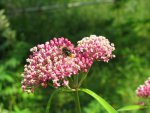I actually bought milkweed seeds yesterday! Quick question, will the milkweed spread out and produce more and more of itself? I hope so because I would rather not keep buying seeds if it self sows.
You are using an out of date browser. It may not display this or other websites correctly.
You should upgrade or use an alternative browser.
You should upgrade or use an alternative browser.
Will butterfly flower self seed itself?
- Thread starter CrazyConure
- Start date
- Joined
- Jan 6, 2016
- Messages
- 1,204
- Reaction score
- 2,754
- Location
- Russia , Moscow
- Hardiness Zone
- 6 b
- Country

JBtheExplorer
Native Gardener
I actually bought milkweed seeds yesterday! Quick question, will the milkweed spread out and produce more and more of itself? I hope so because I would rather not keep buying seeds if it self sows.
Yes, but some milkweed species self-seed better than others. If you collect the pods when they ripen, just before they pop open and the seeds go flying away in the wind, you can separate the seed from the "fluff" that it uses to fly away and scatter the seeds wherever you want them. Then, you have a great chance for new plants to grow. If you have a specie that spreads by rhizomes (most do, but some spread slower than others), then you'll get new plants that way, too.
Sometimes Large Milkweed Bugs will suck the juices out of the seeds. It can be frustrating if you're wanting to collect good seeds, but it's important to remember that the Large Milkweed Bug is just like the Monarch. It requires milkweed to survive.
- Joined
- Feb 2, 2016
- Messages
- 1,803
- Reaction score
- 2,058
- Location
- Colima, Mexico
- Hardiness Zone
- USDA Zone 11
- Country

- Joined
- Sep 10, 2014
- Messages
- 2,794
- Reaction score
- 3,987
- Location
- central Texas
- Showcase(s):
- 1
- Country

This is Asclipias viridiflora known as green milkweed. It grows in our pasture, and we are careful not to mow it down when the Monarchs are migrating.
We get instars (caterpillars) on the milkweed, then they go into pupae stage and develop into Monarch butterflies.
We also have Antelope Horn milkweed (Asclepias asperula) that the Monarchs use. Mowing in the spring and early summer is more of an exercise in avoiding plants than taking them down!
- Joined
- Jan 6, 2016
- Messages
- 1,204
- Reaction score
- 2,754
- Location
- Russia , Moscow
- Hardiness Zone
- 6 b
- Country

Nice to hear that it grows at your house too
@Beverly I'm also pleased to see my home Pachystachys in your garden.
This is Asclipias viridiflora
I do not get tired of being surprised by the variety of species of the same plant. It seems that any Asklepias attracts insects.
- Joined
- Feb 2, 2016
- Messages
- 1,803
- Reaction score
- 2,058
- Location
- Colima, Mexico
- Hardiness Zone
- USDA Zone 11
- Country

@Larisa Wow you grow this too, inside or outside as an annual? Once this plant starts to bloom, it never stops and it is so cheerful, the hummingbirds love the nectar. When i posted the photo i thought it would be a good test for you if you could identify all the plants, or parts of plants...but then i thought no, that is just silly But i am impressed that you know it is a Pachystachys and not a yellow Justicia brandegeeana. They are very similar and often confused
But i am impressed that you know it is a Pachystachys and not a yellow Justicia brandegeeana. They are very similar and often confused 
- Joined
- Feb 2, 2016
- Messages
- 1,803
- Reaction score
- 2,058
- Location
- Colima, Mexico
- Hardiness Zone
- USDA Zone 11
- Country

@CrazyConure there will be two species of Monarch caterpillars that will feed on your milkweed plants. The Monarch (Danaus plexippus) and the Queen (a close relative of the Monarch Danaus gilippus). The Queen is found in Florida and south Texas in the US but doesn't travel much further north. Here are some pics of what you can expect to see in the way of caterpillars, but remember the milkweeds are popular nectar plants for all butterflies, hummingbirds, wasps, bees.
Very young Monarch caterpillar

Mature Monarch caterpillar

Monarch Pupa

Monarch chrysalis

Queen caterpillar (note 3 sets of antennae)

Very young Monarch caterpillar
Mature Monarch caterpillar
Monarch Pupa
Monarch chrysalis
Queen caterpillar (note 3 sets of antennae)
- Joined
- Jan 6, 2016
- Messages
- 1,204
- Reaction score
- 2,754
- Location
- Russia , Moscow
- Hardiness Zone
- 6 b
- Country

@Beverly Pachystachys Pahistahis is very common here, but as a plant inside the house. I also love him for his long flowering. I did not know that the hummingbird pollinated him. 
Other plants? Let's watch.

Liana with orange flowers is Senecio confusus, Mexican Flame Vine. Here you can buy seeds in the "exotic plant store" or small plants from collectors. I really like the plant, but the size is a little scary for me.

A plant with pink flowers, probably Jatropha Multifida.
Well, a palm tree, most likely, Chamaedorea.
I envy you a little for the good, because you can grow such wonderful plants in your garden. In addition, Mexico is home to some species of Achimenes, the hybrids of which I really love.
Other plants? Let's watch.

Liana with orange flowers is Senecio confusus, Mexican Flame Vine. Here you can buy seeds in the "exotic plant store" or small plants from collectors. I really like the plant, but the size is a little scary for me.
A plant with pink flowers, probably Jatropha Multifida.
Well, a palm tree, most likely, Chamaedorea.
I envy you a little for the good, because you can grow such wonderful plants in your garden. In addition, Mexico is home to some species of Achimenes, the hybrids of which I really love.
- Joined
- Feb 2, 2016
- Messages
- 1,803
- Reaction score
- 2,058
- Location
- Colima, Mexico
- Hardiness Zone
- USDA Zone 11
- Country


- Joined
- Jan 6, 2016
- Messages
- 1,204
- Reaction score
- 2,754
- Location
- Russia , Moscow
- Hardiness Zone
- 6 b
- Country

- Joined
- Feb 2, 2016
- Messages
- 1,803
- Reaction score
- 2,058
- Location
- Colima, Mexico
- Hardiness Zone
- USDA Zone 11
- Country

@Larisa...ohhhh, this is a very different plant than the one i have. The leaves actually look like the leaves of what we think is a Theobroma cacao tree (a Malvaceae). The Dalechampia d. i have is a Euphorb and the leaves are hairy not smooth and not so large and not so deeply veined. All parts of Euphorbs are toxic and the leaves give me an itchy rash. I have it in the garden because it is a host plant for a type of butterfly here and also i think it makes a very pretty vine with lots of color. I don't know what to think of the plant in the photo. It doesn't even look like the same genus never mind species. Now, i am so very curious . I am certain about the identity of my vine. I think i will look up "Dalechampia species" and see if i can find something similar. To me, it looks like someone attached a flower from one plant onto a different plant.
. I am certain about the identity of my vine. I think i will look up "Dalechampia species" and see if i can find something similar. To me, it looks like someone attached a flower from one plant onto a different plant.
- Joined
- Feb 2, 2016
- Messages
- 1,803
- Reaction score
- 2,058
- Location
- Colima, Mexico
- Hardiness Zone
- USDA Zone 11
- Country

@Larisa I found it! Looks like Dalechampia roezliana leaves and all. What do you think?
https://toptropicals.com/catalog/uid/dalechampia_roezliana.htm
I have never seen this species before and the site says it is rare in cultivation so that might be why. It is much smaller than its relative the dioscoreifolia and so would be easier to grow as a house plant.
https://toptropicals.com/catalog/uid/dalechampia_roezliana.htm
I have never seen this species before and the site says it is rare in cultivation so that might be why. It is much smaller than its relative the dioscoreifolia and so would be easier to grow as a house plant.
Last edited:
- Joined
- Jan 6, 2016
- Messages
- 1,204
- Reaction score
- 2,754
- Location
- Russia , Moscow
- Hardiness Zone
- 6 b
- Country

- Joined
- Feb 2, 2016
- Messages
- 1,803
- Reaction score
- 2,058
- Location
- Colima, Mexico
- Hardiness Zone
- USDA Zone 11
- Country

I have never really explored the world of the Euphorbs but i learned when exploring the Dalechampias a little bit, that it is quite a diverse world. I think one Euphorb in my small garden is enough Oh, i guess the Jatropha are Euphorbs and i have a multifida and integerrima so i will have to say 3 Euphorbs are enough for my small garden
Oh, i guess the Jatropha are Euphorbs and i have a multifida and integerrima so i will have to say 3 Euphorbs are enough for my small garden
Last edited:
Ask a Question
Want to reply to this thread or ask your own question?
You'll need to choose a username for the site, which only take a couple of moments. After that, you can post your question and our members will help you out.
Similar Threads
Forum statistics
Latest Threads
-
Help! How can I save my acer with scorched leaves?
- Started by Burvs
-
The Garden of England
- Started by zigs
-
My Petunias Got Snowed On!
- Started by david_d
-
New garden need help
- Started by nbryant1
-
Wisteria & Squirrels
- Started by peterpies
-
Invasive Helianthus
- Started by RobGardener
-
Holly close to my house
- Started by robert a
-
Preparing flower beds?
- Started by JMBrowning
-
Must have been mislabeled
- Started by Texas001
-
Selling sites for carnivorous plants
- Started by texc16195

